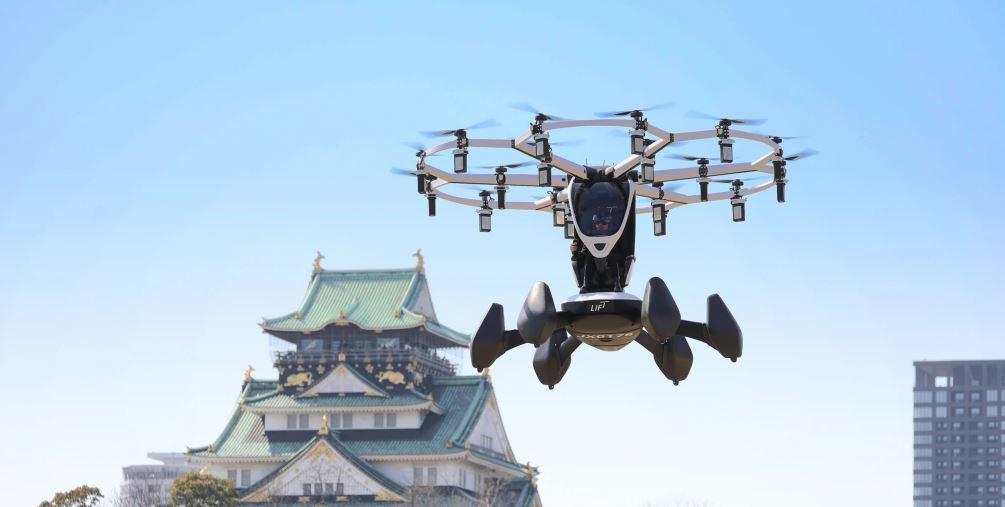
The Hexa is designed to carry a single passenger up to 15 mi. at a maximum cruise speed of 55 kt.
LIFT Aircraft is one of a growing number of startups chasing the nascent market for personal electric-vertical-takeoff-and-landing (eVTOL) vehicles, but the company’s focus on operating its own vertiports for experiential flight services makes it unique among the pack.
Based in Austin, Texas, LIFT is developing a single-seat unwinged multicopter called the Hexa. The 432-lb. aircraft is powered by 18 sets of batteries, electric motors and propellers, with a 15-min. endurance and maximum cruise speed of 55 kt. (63 mph).
LIFT has designed the Hexa to fly as an ultralight aircraft under the FAA’s Part 103 rules, meaning its pilots will not require any training or certificate. But the company will provide on-location training using its virtual reality simulators, and the vehicle is very simple to operate with a single three-axis joystick and autopilot mode available via a small touchscreen display.
Speaking to the AAM Report, LIFT founder and CEO Matt Chasen says he envisions the Hexa’s major use case to be purely recreational flights booked by tourists and private individuals for around $250 per flight at the company’s vertiports, which will mainly be located on the peripheries of large metro areas, as the vehicles are not intended to operate over congested areas and people as per the FAA’s Part 103 rules.
“Our initial use case is one that I think is going to be larger than people think and also very profitable,” Chasen says. He compared the experiential application of eVTOL technology in the early stages of adoption to early tourism services that have sprung up across the commercial space industry.
“We think it’s kind of wired into human DNA to want to experience freedom from gravity–and not like flying in a commercial airliner at 30,000 feet—but self-flying a small aircraft yourself,” Chasen adds. “It’s an incredible feeling, but at the same time we know commercial aviation is not within reach for everyone. Through the Hexa, we can help let everyday people experience that amazing feeling of flight.”
LIFT has collaborated with the U.S. Air Force through the Agility Prime program, with service members testing the Hexa at Eglin AFB, Florida. The Air Force testing program has focused on flight envelope expansion, acoustics testing and development of a modular cargo application for the aircraft, allowing the military to explore potential use cases for a quiet, electrified personal mobility platform.
“On the cargo side, it could be used like a flying pallet, moving and resupplying supplies, goods and ammunition up to 15 miles,” Chasen says. “We could also use it for emergency response or extraction of special forces ... Really, the Air Force is just investing in the technology and they want to track the capabilities as they emerge and then determine how to utilize them.”
The company in March deployed the Hexa to Japan, where it operated the first piloted eVTOL flight ever in the country. In collaboration with Marubeni and GMO Internet Group, and with officials from the Japan Civil Aviation Bureau in attendance, the aircraft completed numerous demonstrations in Osaka, Nihama and Imabari, including a flight at Osaka Palace piloted by GMO Internet Group CEO Masatoshi Kumagi.
Back stateside, the company has invited several hundred early investors to its Austin headquarters to conduct beta flights and provide feedback about the user experience and vehicle design. “We’re using the beta testers to fine-tune the customer experience, the reservation system and the training program, and getting feedback about what works well and what doesn’t,” Chasen says.
LIFT is considering making its vehicles available for sale to private users, but its primary focus is on renting them out for flights at its vertiport bases, where the company operates ground control and air traffic control stations, allowing it to remotely monitor flights, geofence the flightpath and scan the airspace for obstructions.
Chasen said the company may also allow individuals to own their own Hexas that get stored at the vertiports, or even consider sale-leasebacks in some cases to lease the planes back to LIFT for operation in experiential flights. But even in those cases, Chasen said he wants to keep the aircraft at the company’s stations to maintain control over their safe operation.
“From a personal ownership standpoint, these are quite expensive vehicles, so we think that’s a pretty small market,” Chasen says. “At least early on, we feel it’s safer for these aircraft to be flown and maintained with our support directly out of our vertiports.”
There are currently 15,000 people who have paid deposits and signed up to the company’s wait-list, according to Chasen, indicating strong demand to be among the first to operate the vehicles.
Chasen said he expects the first commercial flight services with the Hexa to become operational in the third or fourth quarter of 2023.





